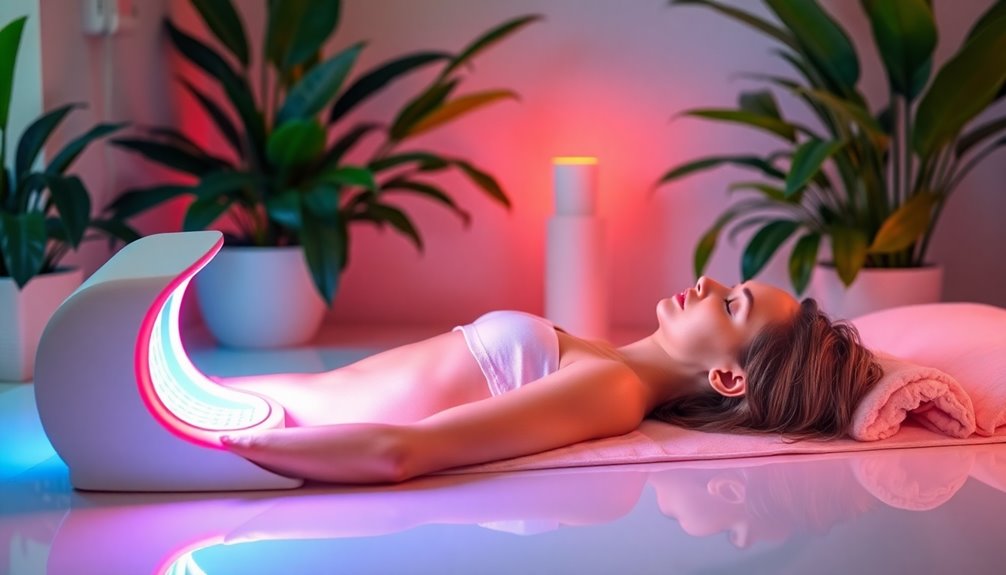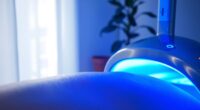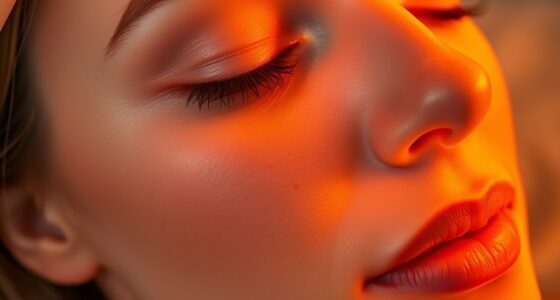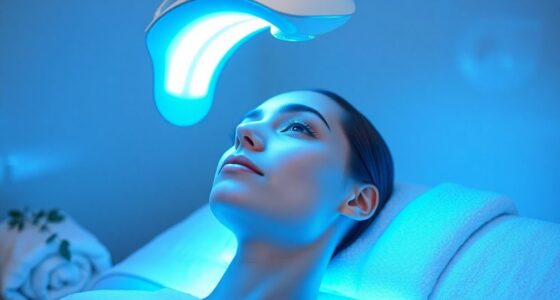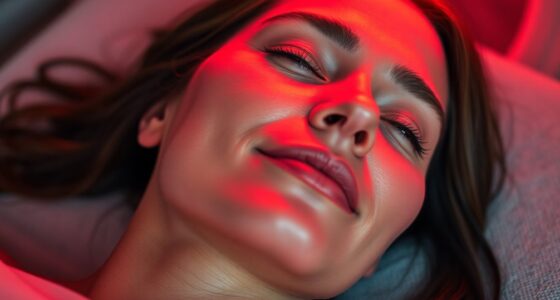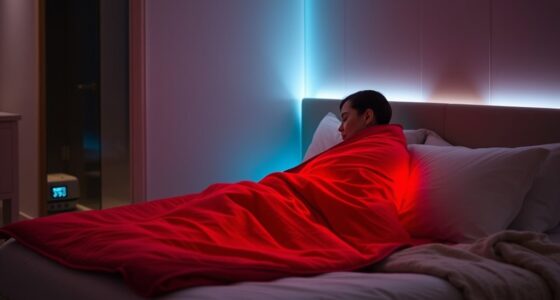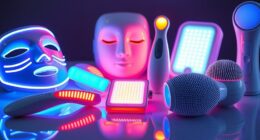Combining red and blue light therapy delivers significant benefits for your health. It enhances cellular energy and circulation by improving oxygen delivery and ATP production, aiding tissue repair. Your skin will reap rewards, too, with increased collagen production and effective acne treatment, resulting in a radiant complexion. This synergy also reduces inflammation and alleviates pain, promoting better recovery from injuries. Plus, you’ll experience improvements in mood, cognitive function, and overall well-being. Embracing this combined approach can transform your health in various ways. To uncover even more insights, stick around for a deeper look into these incredible therapies. Additionally, incorporating this innovative treatment into your wellness routine can help combat signs of aging, making your skin appear youthful and vibrant. By combining red and blue light therapy, you can tackle multiple skin concerns simultaneously, streamlining your skincare regimen. As you experience these numerous benefits, you’ll find that this holistic approach not only enhances your physical appearance but also fosters a deeper sense of self-care and vitality.
Key Takeaways
- Combining red and blue light therapy enhances cellular energy and circulation, promoting better oxygen delivery and tissue repair.
- The therapies work synergistically to improve skin health by boosting collagen production and targeting acne-causing bacteria for clearer skin.
- Both therapies effectively reduce inflammation and pain, providing holistic management for chronic pain and soothing irritated skin.
- Light therapy enhances mental and emotional well-being, improving mood, alertness, and stress management while supporting skin healing.
- Utilizing combined therapies under professional supervision ensures safety, maximizing benefits while minimizing potential side effects.
Enhanced Cellular Energy
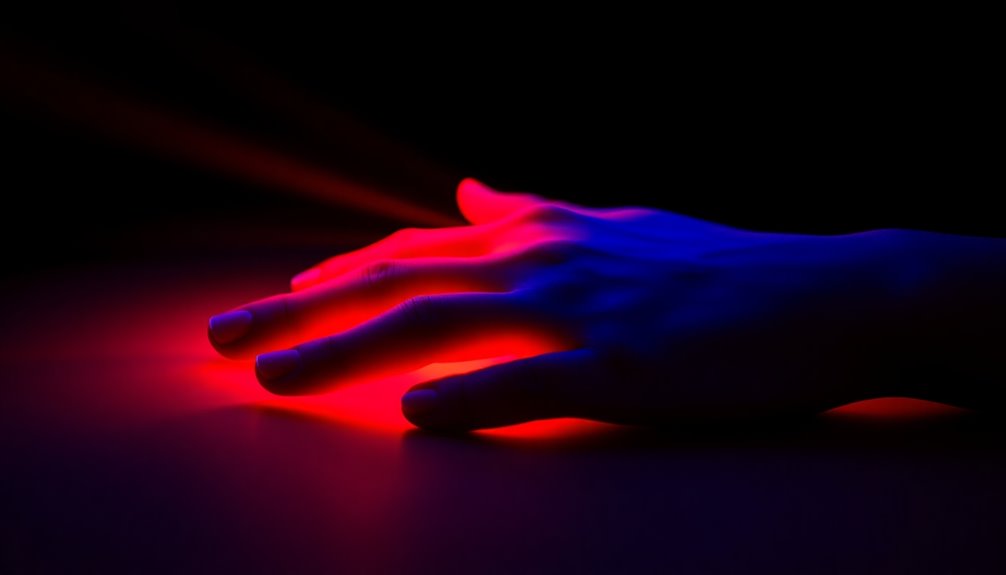
When you harness the power of red light therapy, you'll notice a significant boost in your cellular energy. This therapy stimulates mitochondrial function, enhancing ATP production, which fuels essential biological processes.
As red light penetrates your skin, it improves cellular respiration by stimulating cytochrome c oxidase, leading to more efficient ATP synthesis. You'll also experience increased blood flow, enhancing oxygen delivery to your cells and supporting energy production. This process not only promotes tissue repair and regeneration but also encourages cellular turnover, improving your skin's texture and tone. Overall, red light therapy acts as a catalyst for enhanced cellular energy, helping you feel more vibrant and energized throughout your day. Additionally, the combination of red and blue light therapy can further improve skin vitality by targeting acne-causing bacteria and promoting a more even skin tone.
Reduced Inflammation
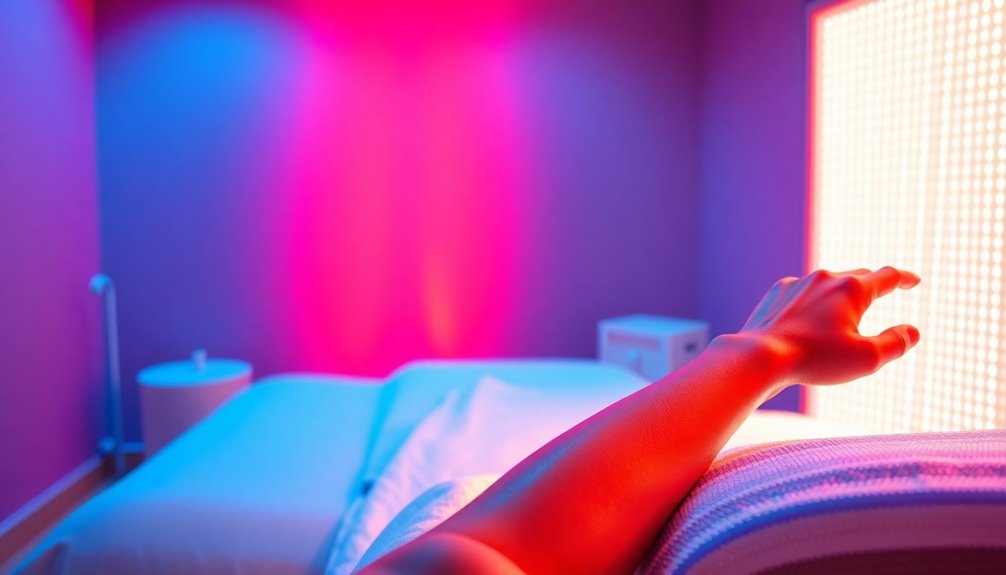
In addition to boosting cellular energy, red and blue light therapies play a significant role in reducing inflammation.
Red light therapy penetrates deeper into the skin, targeting inflammatory molecules effectively. It decreases the expression of inflammatory mediators from macrophages, leading to reduced neutrophils and interleukins, which is particularly beneficial for conditions like acne. Light therapy has been shown to be effective in reducing inflammation at a cellular level, further enhancing its therapeutic benefits.
On the other hand, blue light therapy tackles bacteria that contribute to inflammation, enhancing wound healing and minimizing the inflammatory response.
When combined, these therapies synergistically target different skin layers to alleviate redness and inflammation. This dual approach not only speeds up recovery but also provides a safe and effective treatment for various skin issues, making it a valuable addition to your wellness routine.
Increased Circulation
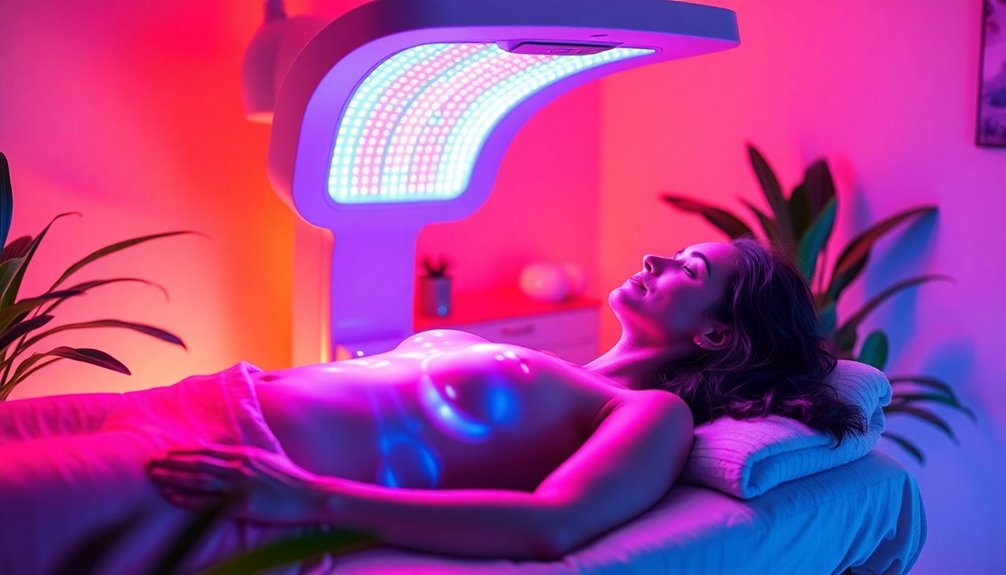
Combining red and blue light therapies not only reduces inflammation but also significantly boosts circulation.
Blue light therapy stimulates nitric oxide production, acting as a vasodilator that expands blood vessels, enhancing blood flow to the treated area. This increased circulation delivers more oxygen and nutrients to tissues, supporting your overall health. Additionally, effective keyword research can identify specific conditions that may benefit from enhanced circulation through light therapy.
Meanwhile, red light therapy activates mitochondria, improving ATP production and promoting the growth of endothelial cells, which form blood vessels. By releasing nitric oxide, red light also contributes to vasodilation. Notably, both therapies utilize different wavelengths on the electromagnetic spectrum, which allows them to work synergistically.
Together, these therapies enhance oxygen delivery and nutrient transport, improve cellular respiration, and can even lower blood pressure.
You'll feel the benefits of improved circulation throughout your body, leading to enhanced vitality and wellness.
Improved Skin Health
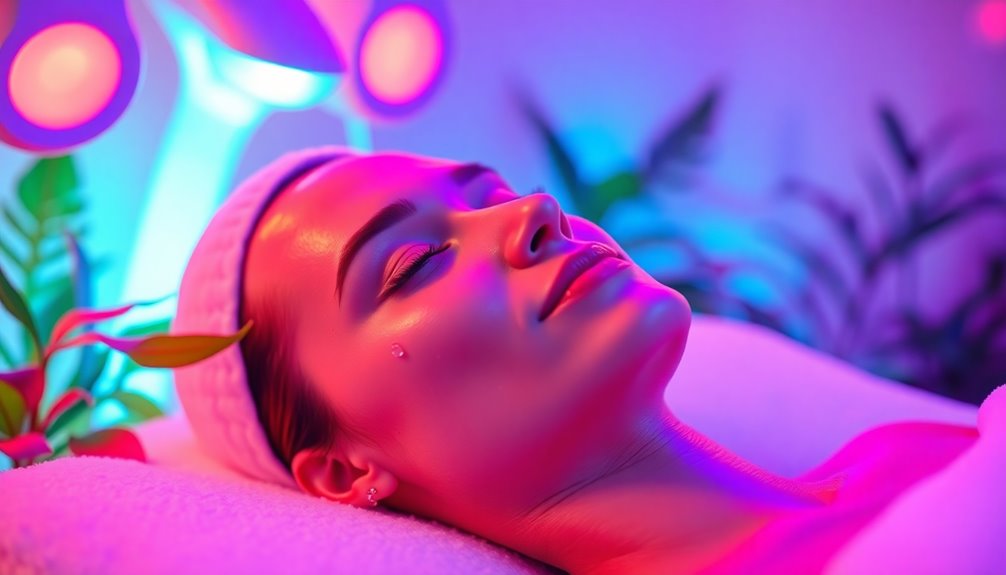
As you explore the benefits of red and blue light therapy, you'll discover that these treatments can significantly improve your skin health.
Red light therapy boosts collagen production, helping to reduce fine lines, wrinkles, and sagging skin, leaving you with a firmer and more youthful appearance.
Meanwhile, blue light therapy effectively targets acne-causing bacteria, reducing breakouts and easing inflammation for clearer skin.
Together, they enhance skin texture and tone by promoting cellular turnover and minimizing pores.
You'll notice improvements in skin clarity and a reduction in hyperpigmentation, leading to a more even complexion. Additionally, the combination of increased blood circulation enhances overall skin health, promoting a radiant glow.
Regular use of these therapies not only rejuvenates your skin but also accelerates healing and recovery, making it a powerful duo for enhanced skin health.
Enhanced Pain Relief
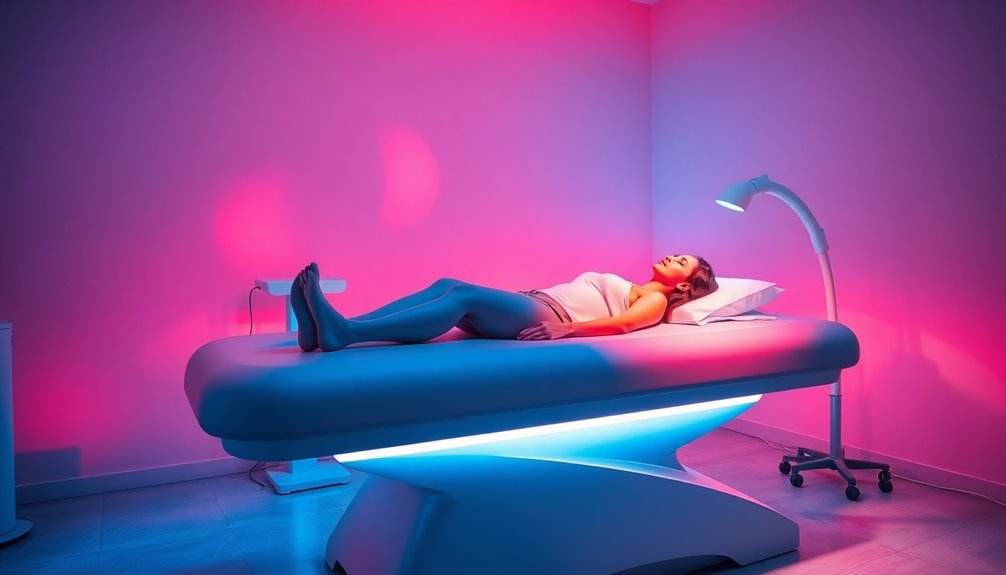
While enhancing skin health is a significant benefit of red and blue light therapy, these treatments also offer remarkable pain relief. The anti-inflammatory effects of both therapies play a crucial role in managing pain, with blue light soothing irritated skin and modulating sensory neurons. This combination can amplify their individual benefits, leading to enhanced relief. Blue light also modulates nociceptive fibers, helping reduce both spontaneous and evoked pain. Clinical evidence supports these claims, showing significant pain intensity reduction in chronic back pain patients after blue light exposure. Additionally, red light enhances ATP production, indirectly alleviating discomfort. Furthermore, blue light treatment has been shown to significantly reduce spontaneous pain, highlighting its effectiveness in pain management. Together, red and blue light therapies create a powerful synergy for effective pain management, providing you with a holistic approach to relief.
Muscle Recovery
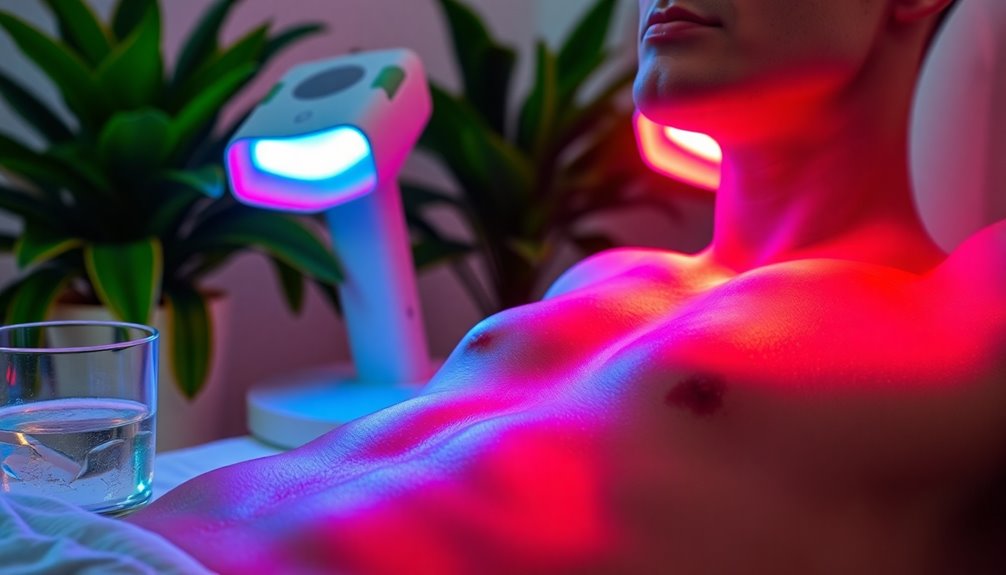
When you engage in intense physical activity, muscle recovery becomes essential for maintaining performance and preventing injury.
Combining red and blue light therapy can significantly accelerate muscle regeneration by boosting ATP production, enhancing protein synthesis, and repairing damaged muscle fibers. This therapy reduces oxidative stress, which often hinders recovery, while improving overall muscle function. Additionally, it helps reduce muscle soreness and inflammation by improving blood circulation and regulating the body's inflammatory response. Red light therapy is known to penetrate skin to varying depths, allowing for targeted treatment of specific muscle groups.
You'll experience less delayed onset muscle soreness (DOMS), allowing you to return to training quicker. Enhanced blood flow not only delivers more oxygen to your recovering muscles but also facilitates the removal of metabolic waste, supporting cellular repair and promoting long-term recovery.
Mental Health Benefits
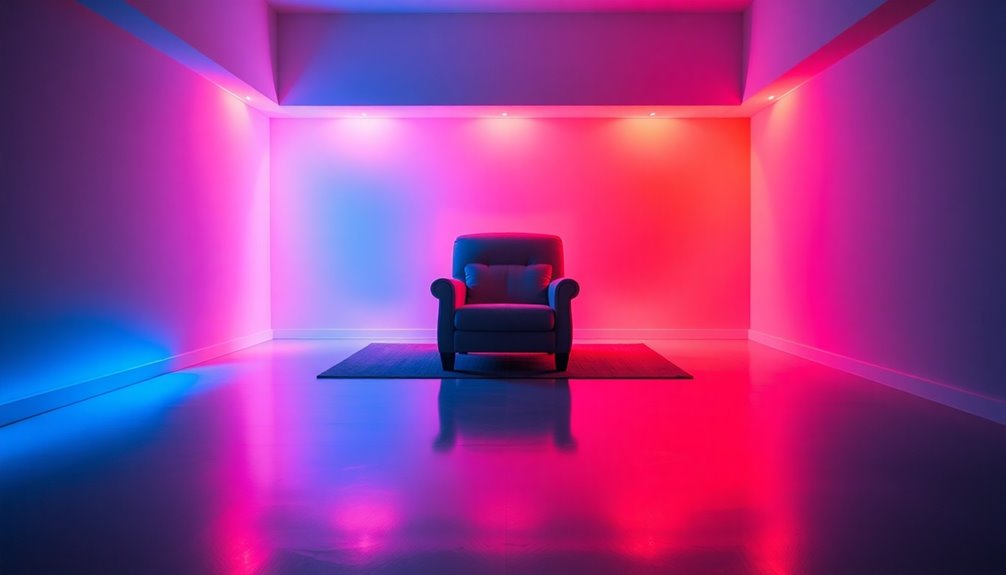
Combining red and blue light therapy offers significant mental health benefits that can enhance your overall well-being.
Red light therapy can help modulate serotonin levels, providing relief from depression while stabilizing your mood. It promotes better sleep quality, which is crucial for those battling anxiety and depressive symptoms. The calming effect of red light therapy also influences the autonomic nervous system, reducing anxiety and fostering relaxation. Additionally, red light therapy is known for its ability to improve sleep quality without disrupting melatonin production, which is essential for restorative sleep.
Meanwhile, blue light therapy effectively regulates circadian rhythms, combats Seasonal Affective Disorder, and boosts mood by increasing serotonin production.
Together, these therapies improve cognitive function, enhance alertness, and reduce fatigue, empowering you to manage stress more effectively and achieve a clearer, more focused mind.
Holistic Well-being
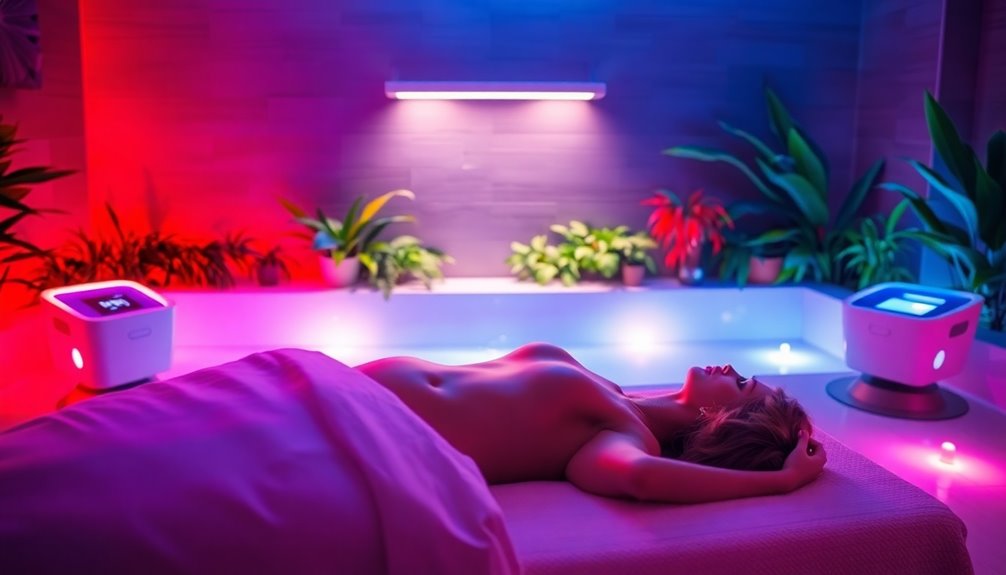
Exploring holistic well-being means recognizing the interconnectedness of mental, physical, and emotional health.
Combining red and blue light therapy can significantly enhance your overall wellness. Red light therapy improves skin texture, reduces fine lines, and promotes healing of acne scars, helping you feel more confident in your appearance. Additionally, it stimulates cellular regeneration, further enhancing the skin's healing process and vitality.
Simultaneously, blue light therapy targets harmful bacteria and reduces inflammation, addressing skin conditions like rosacea. You'll also experience relief from chronic pain and joint stiffness, allowing you to move freely.
Regular sessions can boost your mood, regulate sleep patterns, and elevate your energy levels. Embracing this dual approach can transform how you feel both inside and out, fostering a balanced and vibrant life.
Safety and Considerations
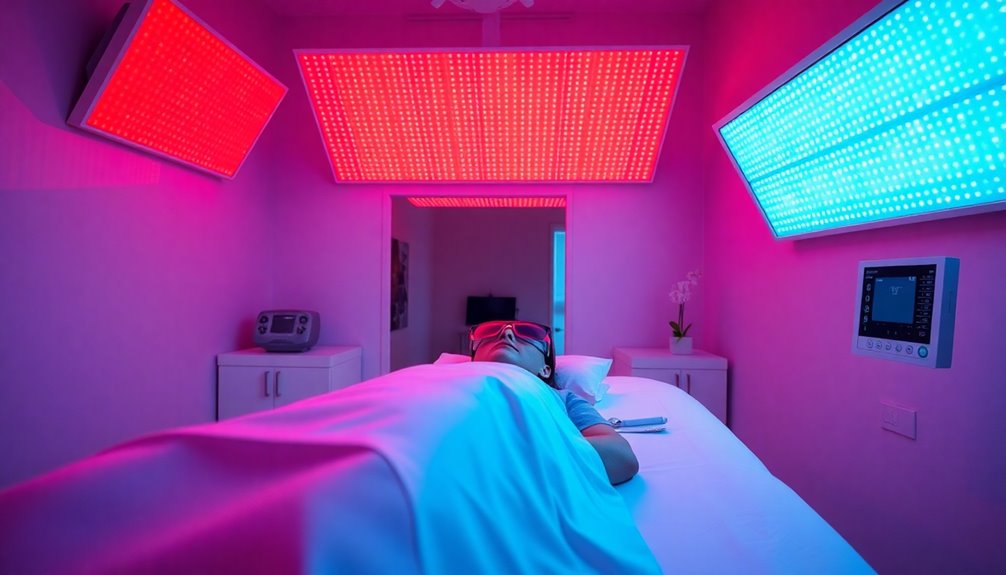
While red and blue light therapies offer numerous benefits, it's crucial to prioritize safety and consider potential risks. Generally, these therapies are safe, but high-strength lights can cause skin redness or blistering.
Always wear protective goggles to prevent eye damage, especially with at-home devices. Combining red and blue therapies is typically safe under professional guidance, enhancing skin healing and reducing acne. However, be mindful of rare side effects like increased inflammation or rash.
After photodynamic therapy, avoid sunlight for 48 hours and apply sunblock regularly. Long-term safety remains less studied, so always use FDA-cleared devices and follow instructions carefully. Mitochondria absorb light during these therapies, which boosts energy production in your cells.
If you have conditions like porphyria or lupus, consult a professional before starting therapy.
Frequently Asked Questions
How Long Does a Typical Light Therapy Session Last?
A typical light therapy session lasts between 20 to 30 minutes.
You might start with shorter sessions around 15 minutes, gradually increasing the duration as you get accustomed.
The exact time can vary based on the intensity of the light and your individual response.
Consistency is key, so aim for daily sessions to see noticeable improvements in your mood and overall well-being.
Always consult a healthcare professional for personalized recommendations.
Is Blue Light Therapy Safe for All Skin Types?
Like a gentle breeze through a sunlit garden, blue light therapy embraces your skin with safety in mind.
It's FDA-approved and free from UV rays, keeping your skin cancer risk at bay.
You might experience mild side effects like dryness or stinging, but nothing serious lingers long-term.
With a dermatologist's guidance, you can confidently explore this treatment, knowing it's suitable for all skin types, even those kissed by the sun.
Can I Use Light Therapy at Home?
Yes, you can use light therapy at home! Just make sure you choose FDA-cleared devices for safety.
Always wear eye protection to prevent damage and carefully follow the usage instructions.
While at-home devices may offer subtle improvements in your skin, consistency is key; regular treatments will yield better results.
Keep in mind that some side effects can occur, so stay aware of your skin's reaction and consult a professional if needed.
How Often Should I Undergo Combined Light Therapy?
Imagine your skin is a garden, needing care and attention. For combined light therapy, you should visit the treatment "garden" 2-3 times a week if you're going in-office, or 3-5 times at home.
Stick with this routine for 4-6 weeks, then consider maintenance sessions every few months.
Remember, alternating red and blue light is like watering your plants; it helps them thrive and stay vibrant.
Adjust based on your skin's response to the treatment.
Are There Any Side Effects of Red and Blue Light Therapy?
Yes, there are side effects associated with red and blue light therapy.
You might experience headaches, eye strain, or mild skin irritation like redness or itching.
In some cases, high-intensity exposure can lead to blistering or more serious reactions.
It's crucial to use protective eyewear and follow usage guidelines to minimize risks.
If you're on certain medications, consult your doctor to avoid complications or heightened sensitivity during treatment sessions.
Conclusion
Combining red and blue light therapy offers a powerful array of benefits, from boosting cellular energy to enhancing mental well-being. Imagine feeling a surge of vitality as inflammation fades and circulation improves. Picture your skin transforming, pain alleviating, and muscles recovering faster than ever. But what if there's even more to discover? As you explore this innovative therapy, you might uncover hidden layers of wellness waiting just for you. Are you ready to unlock the full potential?
